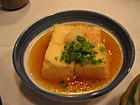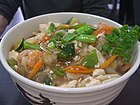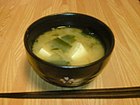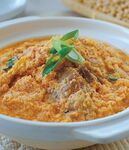Course:FNH200/Projects/2020/Tofu
Introduction
Originated from China, tofu is a food that many people, especially Asians, have been enjoying. There are a lot of different tofu dishes from different parts of Asia such as China, Japanese, Korea and Indonesia. It has also gained its popularity in other parts of the world due to the various health benefits that it offers. Tofu is a good source of protein[1], making it a suitable substitute of meat for vegans. It also contains fibre as well as a variety of minerals such as potassium, magnesium, iron, copper and manganese.[1] Tofu is made of soybeans that are soaked in water, heated and coagulated with calcium or magnesium salt, and the resulting curd is then pressed into blocks. [2] There are different types of tofu which are extra-firm tofu, firm tofu, soft tofu and silken tofu, depending on its softness.[3]
History of Tofu
Tofu was first discovered about 2,000 years ago in China.[4] However, there are different theories regarding the origin of tofu such as the Liu An theory, Accidental Coagulation theory, Indian Import theory, and Mongolian Import theory. [5] The Liu An theory states that tofu was invented by Liu An, a Han Dynasty prince.[5] The Accidental Coagulation theory states that tofu was invented by accident around AD 600 in Northern part of China.[5] The Indian Import theory states that tofu was imported from India by the dairying tribes or Buddhist monks.[5] The Mongolian Import theory states that the idea of tofu innovation was modified from cheese making process which came from milk-drink Mongolian tribes that lived in Northern border of China. [5]
Processing
Processing of soybeans
The first step in the production of tofu is soaking the soybeans. Soaking helps to accelerate the extraction of protein from the beans[6], which creates tofu with better protein content. In some cases, removal of soybean hulls happens first before soaking, which helps to make the colour and taste of tofu more appealing.[7] The protein content and texture of tofu can also be improved by freezing the soaked soybeans or by using sprouted soybeans in the production process.[8]
Afterwards, soaked soybeans are ground to form a slurry.[7] This soybean slurry can be treated in three different ways before being filtrated to obtain soy milk: without cooking, with cooking or hot water mixing.[8] During filtration, soy milk is separated from the soy pulp (okara), generating soy milk with 10% to 22% solid content.[7]
Coagulation of soy milk
After filtration, the soy milk is coagulated to solidify the protein and oil present in it. There are three different types of coagulants commonly used in tofu production: salts, acids and enzymes. These coagulants can be used by themselves or in combination with one another.[7]
Salt coagulants
Calcium sulfate is the most commonly used salt coagulant in tofu production[7], which also creates the unique aroma and taste of tofu[8]. Another type of salt coagulant is nigari, which consists of magnesium chloride combined with calcium chloride. Since nigari is produced by removing sodium chloride and evaporating seawater, its contents can vary depending on the components of seawater used, which may be difficult to use in standardized large-scale tofu production.[7]
Acid coagulants
Edible acids like glucono delta-lactone (GDL) are used as coagulant in the production of soft or silken tofu, as it creates a softer tofu texture in a shorter time.[8] This allows silken or soft tofu to be produced directly in its container, reducing the formation of air gaps such that they can be transported without breaking.[7] Calcium sulfate is often used together with GDL to minimize the sour taste of the final product.
Enzyme coagulants
Enzymes such as papain and proteases can be used as a coagulant as it helps to catalyze cross-linking between amino acids in the proteins.[7]
Pressing and packaging of tofu
Tofu pressing is especially important in the production of firmer tofu as it squeezes excess liquid out of the soy curd. It is often done with a hydraulic press, where the soy curd is pressed with varying weights to reach the desirable firmness.[7] The heavier the weight used, the firmer the tofu will be. Afterwards, the pressed tofu is cut into desired sizes and packaged. Pasteurization or UHT (ultra high temperature) technology and aseptic packaging are often used to increase the shelf life of tofu.[7]
Silken or soft tofu production does not involve pressing, as the coagulation process happens directly inside the packaging with the help of water bath to maintain the optimum temperature for the coagulants to work.[7]
Varieties
Varieties of Fresh Tofu can be divided into two big categories; silken and regular tofu. Fresh tofu is usually categorized further by its firmness. It is based on how much water is pressed out of the tofu; the more is pressed out, the firmer it gets while simultaneously increasing its protein and fat content. [9]
Silken Tofu
The type of tofu with the highest water content with a custard-like texture. Silken’s tofu consistency depends on the amount of soy it contains. Its texture made silken tofu a perfect substitute for almost everything from soy milk to cream. It is used in a lot of vegan recipes as a substitute for eggs and dairy products[10]. Silken tofu is usually labeled as soft, firm, or extra firm; however, the difference is minimal.
Regular tofu
Regular tofu or non-silken tofu is pressed tofu with a sponge-like texture. It comes in varieties from soft tofu up to super firm tofu; the more firm the tofu, the denser it gets and has lower moisture. The more solid the tofu, the harder it is to infuse flavour to the tofu, which is a crucial consideration in choosing what tofu to use. [9]
Soft tofu
This is the Chinese equivalent of silken tofu with similar properties, making it used in similar ways when cooked. However, compared to silken tofu, it is less smooth. [9]
Medium tofu
Denser than soft tofu but still have a delicate texture. Used in soups such as miso or frequently served cold.[9]
Firm tofu
Normally stir-fried or pan friend[10], this kind of tofu absorbs flavours well. How well firm tofu hold its structure is based on the brand and its production. Firm tofu may also be scrambled in food and substitute to ricotta cheese in vegan recipes[9].
Extra-firm tofu
This kind of tofu holds its shape very well, making it great to cut, slice, cube, all kinds of frying, baking, and grilling as it won’t easily crumble down like the softer tofus when being cooked. In vegan dishes, it is sometimes used as a substitute for ground meat by crumbling it down before cooking[9].
Super firm tofu
This kind of tofu is very dense with high protein content. Excellent when it is cooking in a hurry as it would not fall apart, and there is less water to cook. However, because of its low moisture, it dries out fast when baked or grilled high heat[9].
Tofu dishes
Indonesia
Tofu has been a staple in Indonesian dishes for many many years now. Almost every region and province in Indonesia has their own tofu dish. They are often fried, sautéed, poached, and many more.
Here are some examples of tofu dishes in Indonesia:
China
Some would say that tofu in China is synonymous to pasta in Italy. It plays a really important role in Chinese culture and diet.
Here are some examples of Chinese tofu dishes:
Japan
Tofu in Japan has also been especially popular and important. Here are some dishes served in Japan:
South Korea
South Korea also has many tofu dishes. They are mostly eaten as sides, but has many main dishes that use tofu as the star of the show. Here are some dishes:
Potential Final Exam Question
What thermal preservation method is commonly used in the processing of tofu?
A. UHT
B. Pasteurization
C. Commercial sterilization
D. A and B only
E. All of the above
Explanation:
After firm tofu is pressed and cut, it will then be packaged in individual packagings. In order to increase the shelf life of tofu, packaged tofu is usually pasteurized at about 180°F (82°C)[11].
Ultra-high temperature (UHT) processing can also be used in which the soy milk is heated to a temperature between 60°C and 105°C, deaerated and homogenized in order to create aseptic soy milk. This aseptic soy milk will then be coagulated, pressed and packaged in aseptic packaging[12].
References
- ↑ 1.0 1.1 Pirnak, Jess (15 January 2019). "Tofu 101: The Health Benefits of Tofu and How to Cook It". Food Yourself.
- ↑ Migala, Jessica (6 September 2019). "A Detailed Guide to Tofu: How It's Made, Whether It's Good for You, and How to Prepare It". Everyday Health.
- ↑ Han, Emily (28 March 2014). "What's the Difference Between All Types of Tofu?". kitchn.
- ↑ "History of Tofu". Soya.be. 2015.
- ↑ 5.0 5.1 5.2 5.3 5.4 Shurtleff, William; Aoyagi, Akiko (2004). "History of Tofu".
- ↑ Yang, A. J.; James, A. T. (2016). "Comparison of two small-scale processing methods for testing silken tofu quality". Food Analysis Method. 9: 385–392.
- ↑ 7.00 7.01 7.02 7.03 7.04 7.05 7.06 7.07 7.08 7.09 7.10 "How Tofu is Processed". Institute of Food Technologists.
- ↑ 8.0 8.1 8.2 8.3 Qing Zhang, Chenzhi Wang, Bokang Li, Lin Li, Derong Lin, Hong Chen, Yaowen Liu, Suqing Li, Wen Qin, Jiang Liu, Weiguo Liu & Wenyu Yang. (2018). Research progress in tofu processing: From raw materials to processing conditions, Critical Reviews in Food Science and Nutrition, 58:9, 1448-1467
- ↑ 9.0 9.1 9.2 9.3 9.4 9.5 9.6 Han, Emily (28 March 2014). "What's the Difference Between All the Types of Tofu?". Kitchn.
- ↑ 10.0 10.1 Hackett, Jolinda (21 May 2020). "The Difference Between Silken and Regular Tofu". the spruce eats.
- ↑ "How tofu is made". How Products are Made.
- ↑ "Method for producing an aseptic packaged tofu product". Free Patents Online (FPO).


























